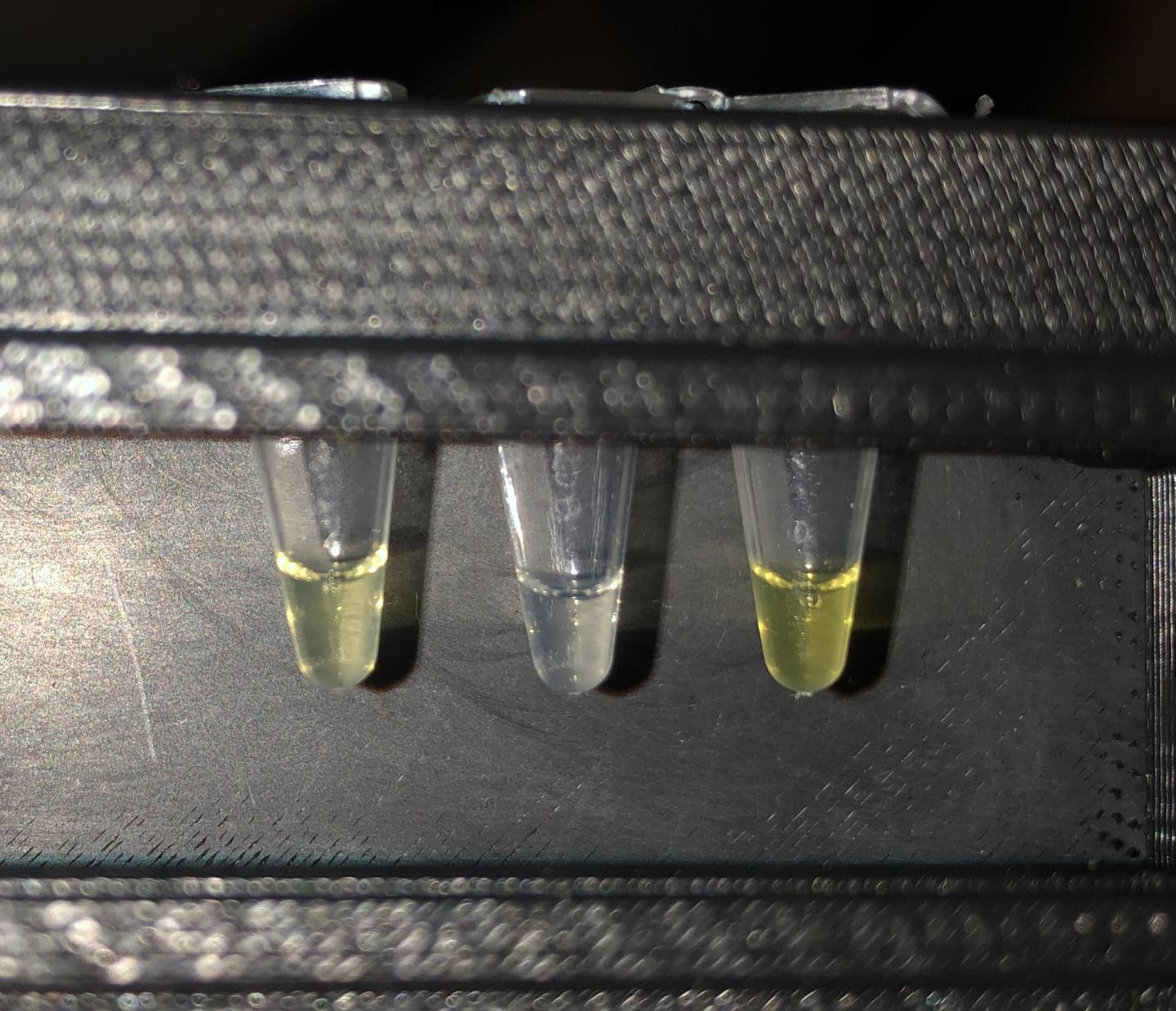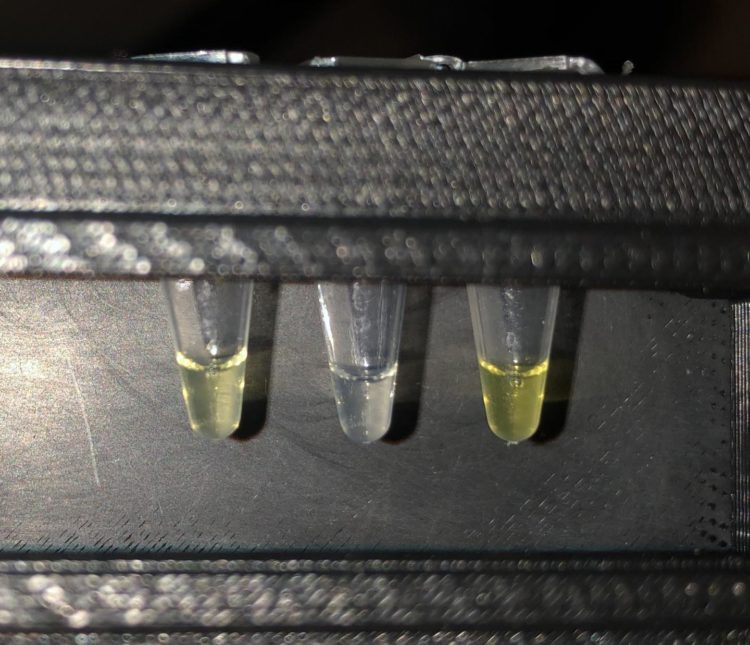Method uses synthetic biology to detect dangerous levels of fluoride in drinking water

Credit: Julius B. Lucks/Northwestern University
- With one drop of water, test detects fluoride levels that exceed EPA standards
- Test costs pennies to make, is easy to read and requires no expertise to use
- Method works by using an RNA riboswitch, which flips when fluoride is not present
- Researchers tested device in Costa Rica, where fluorosis has been reported
EVANSTON, Ill. — Northwestern University synthetic biologists developed a simple, inexpensive new test that can detect dangerous levels of fluoride in drinking water.
Costing just pennies to make, the system only needs a drip and a flick: Drip a tiny water droplet into a prepared test tube, flick the tube once to mix it and wait. If the water turns yellow, then an excessive amount of fluoride — exceeding the EPA’s most stringent regulatory standards — is present.
This method is starkly different from current tests, which cost hundreds of dollars and often require scientific expertise to use.
The researchers tested the system both in the laboratory at Northwestern and in the field in Costa Rica, where fluoride is naturally abundant near the Irazu volcano. When consumed in high amounts over long periods of time, fluoride can cause skeletal fluorosis, a painful condition that hardens bones and joints.
Americans tend to think of the health benefits of small doses of fluoride that strengthen teeth. But elsewhere in the world, specifically across parts of Africa, Asia and Central America, fluoride naturally occurs at levels that are dangerous to consume.
“In the United States, we hear about fluoride all the time because it’s in toothpaste and the municipal water supply,” said Northwestern’s Julius Lucks, who led the project. “It makes calcium fluoride, which is very hard, so it strengthens our tooth enamel. But above a certain level, fluoride also hardens joints. This mostly isn’t an issue in the U.S. But it can be a debilitating problem in other countries if not identified and addressed.”
The research was published online last week (Dec. 13) in the journal ACS Synthetic Biology.
Lucks is an associate professor of chemical and biological engineering in the McCormick School of Engineering and a member of Northwestern’s Center for Synthetic Biology. The work was performed in collaboration with Michael Jewett, professor of chemical and biological engineering in McCormick and director of the Center for Synthetic Biology. Graduate students Walter Thavarajah, Adam Silverman and Matthew Verosloff spearheaded the research.
Field test success
Fluoride is a naturally occurring element, which can seep out of bedrock into groundwater. Also found in volcanic ash, fluoride is particularly abundant in regions surrounding volcanoes.
Home to three volcanic range systems, Costa Rica seemed like a natural place to test the device in the field. Matthew Verosloff, a Ph.D. candidate in Lucks’ laboratory, traveled to Costa Rica and sampled various water samples — from mud puddles, ponds and ditches.
“Every test on these field samples worked,” Lucks said. “It’s exciting that it works in the lab, but it’s much more important to know that it works in the field. We want it to be an easy, practical solution for people who have the greatest need. Our goal is to empower individuals to monitor the presence of fluoride in their own water.”
How it works
Although the device is simple to use, the prepared test tube houses a sophisticated synthetic biology reaction. Lucks has spent years working to understand RNA folding mechanisms. In his new test, he puts this folding mechanism to work.
“RNA folds into a little pocket and waits for a fluoride ion,” he explained. “The ion can fit perfectly into that pocket. If the ion shows up, then RNA expresses a gene that turns the water yellow. If the ion doesn’t show up, then RNA changes shape and stops the process. It’s literally a switch.”
According to Lucks, organisms already perform this function in nature. “Fluoride is toxic to bacteria,” he said. “They use RNA to sense fluoride in the cell, then they make a protein to pump it out and detoxify.”
Lucks’ system works in the same way. But instead of producing a protein pump, his test produces a protein enzyme that makes a yellow pigment, so people can see the results with a simple glance.
Lucks’ team freeze-dried the RNA reaction, which looks like a tiny cotton ball, and put it into a test tube. In this form, the reaction is safe and shelf-stable. A small pipette accompanies the test tube. When placed in water, the pipette absorbs exactly 20 microliters — just the small drop that’s needed to rehydrate the reaction. From there, it takes two hours to get a result, which Lucks intends to accelerate in future iterations.
“We’re currently limited to testing for fluoride,” said Thavarajah, the paper’s first author. “But we’re trying to engineer other RNAs to detect all sorts of targets.”
###
The study, “Point-of-use detection of environmental fluoride via a cell-free riboswitch-based biosensor,” was supported by the Air Force Research Laboratory Center of Excellence for Advanced Bioprogrammable Nanomaterials (grant number FA8650-15-2-5518), the David and Lucile Packard Foundation, the National Science Foundation (CAREER 1452441) and the Camille Dreyfus Teacher-Scholar Program.
Media Contact
Amanda Morris
[email protected]
847-467-6790
Original Source
https:/
Related Journal Article
http://dx.





